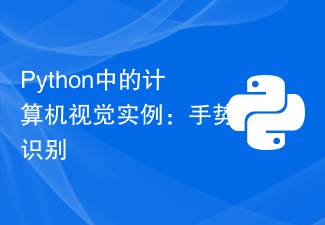 Technology peripherals
Technology peripherals AI
AI Using dimensionality reduction algorithms to achieve target detection: tips and steps
Using dimensionality reduction algorithms to achieve target detection: tips and steps
Object detection is a key task in computer vision, where the goal is to identify and locate objects of interest in images or videos. Dimensionality reduction algorithm is a method commonly used for target detection by converting high-dimensional image data into low-dimensional feature representation. These features can effectively express the key information of the target, thereby supporting the accuracy and efficiency of target detection.
Step 1: Prepare the data set
First, prepare a labeled data set containing the original image and the corresponding region of interest . These regions can be manually annotated or generated using existing object detection algorithms. Each region needs to be annotated with bounding box and category information.
Step 2: Build the model
#In order to achieve the target detection task, it is usually necessary to build a deep learning model that can receive the original image as Inputs and outputs the bounding box coordinates of the region of interest. A common approach is to use regression models based on convolutional neural networks (CNN). By training this model, the mapping from images to bounding box coordinates can be learned to detect regions of interest. This dimensionality reduction algorithm can effectively reduce the dimension of input data and extract feature information related to target detection, thereby improving detection performance.
Step 3: Training the model
After preparing the data set and model, you can start training the model. The goal of training is to enable the model to predict the bounding box coordinates of the region of interest as accurately as possible. A common loss function is the mean square error (MSE), which measures the difference between the predicted bounding box coordinates and the true coordinates. Optimization algorithms such as gradient descent can be used to minimize the loss function, thereby updating the weight parameters of the model.
Step 4: Test the model
After the training is completed, you can use the test data set to evaluate the performance of the model. At test time, the model is applied to images in the test dataset and the predicted bounding box coordinates are output. The accuracy of the model is then evaluated by comparing the predicted bounding boxes with the ground-truth annotated bounding boxes. Commonly used evaluation indicators include accuracy, recall, mAP, etc.
Step 5: Apply the model
After passing the test, you can apply the trained model to the actual target detection task . For each input image, the model will output the bounding box coordinates of the area of interest to detect the target object. As needed, the output bounding box can be post-processed, such as non-maximum suppression (NMS), to improve the accuracy of the detection results.
Among them, step 2 of building the model is a critical step, which can be achieved using deep learning technologies such as convolutional neural networks. During the training and testing process, appropriate loss functions and evaluation metrics need to be used to measure the performance of the model. Finally, through practical application, accurate detection of target objects can be achieved.
Examples of using dimensionality reduction algorithms to achieve target detection
After introducing the specific methods and steps, let’s look at the implementation examples. The following is a simple example written in Python that illustrates how to implement object detection using a dimensionality reduction algorithm:
import numpy as np
import cv2
# 准备数据集
image_path = 'example.jpg'
annotation_path = 'example.json'
image = cv2.imread(image_path)
with open(annotation_path, 'r') as f:
annotations = np.array(json.load(f))
# 构建模型
model = cv2.dnn.readNetFromCaffe('deploy.prototxt', 'res101_iter_70000.caffemodel')
blob = cv2.dnn.blobFromImage(image, scalefactor=0.007843, size=(224, 224), mean=(104.0, 117.0, 123.0), swapRB=False, crop=False)
model.setInput(blob)
# 训练模型
output = model.forward()
indices = cv2.dnn.NMSBoxes(output, score_threshold=0.5, nms_threshold=0.4)
# 应用模型
for i in indices[0]:
box = output[i, :4] * np.array([image.shape[1], image.shape[0], image.shape[1], image.shape[0]])
cv2.rectangle(image, (int(box[0]), int(box[1])), (int(box[2]), int(box[3])), (0, 255, 0), 2)
cv2.imshow('Output', image)
cv2.waitKey(0)This code example uses the OpenCV library to implement object detection. First, a labeled data set needs to be prepared, which contains original images and their corresponding regions of interest. In this example, we assume that we already have a JSON file containing annotation information. Then, build a deep learning model, here using the pre-trained ResNet101 model. Next, the model is applied to the input image to obtain the predicted bounding box coordinates. Finally, the predicted bounding boxes are applied to the image and the output is displayed.
The above is the detailed content of Using dimensionality reduction algorithms to achieve target detection: tips and steps. For more information, please follow other related articles on the PHP Chinese website!
 AI技术在图像超分辨率重建方面的应用Jan 23, 2024 am 08:06 AM
AI技术在图像超分辨率重建方面的应用Jan 23, 2024 am 08:06 AM超分辨率图像重建是利用深度学习技术,如卷积神经网络(CNN)和生成对抗网络(GAN),从低分辨率图像中生成高分辨率图像的过程。该方法的目标是通过将低分辨率图像转换为高分辨率图像,从而提高图像的质量和细节。这种技术在许多领域都有广泛的应用,如医学影像、监控摄像、卫星图像等。通过超分辨率图像重建,我们可以获得更清晰、更具细节的图像,有助于更准确地分析和识别图像中的目标和特征。重建方法超分辨率图像重建的方法通常可以分为两类:基于插值的方法和基于深度学习的方法。1)基于插值的方法基于插值的超分辨率图像重
 尺度转换不变特征(SIFT)算法Jan 22, 2024 pm 05:09 PM
尺度转换不变特征(SIFT)算法Jan 22, 2024 pm 05:09 PM尺度不变特征变换(SIFT)算法是一种用于图像处理和计算机视觉领域的特征提取算法。该算法于1999年提出,旨在提高计算机视觉系统中的物体识别和匹配性能。SIFT算法具有鲁棒性和准确性,被广泛应用于图像识别、三维重建、目标检测、视频跟踪等领域。它通过在多个尺度空间中检测关键点,并提取关键点周围的局部特征描述符来实现尺度不变性。SIFT算法的主要步骤包括尺度空间的构建、关键点检测、关键点定位、方向分配和特征描述符生成。通过这些步骤,SIFT算法能够提取出具有鲁棒性和独特性的特征,从而实现对图像的高效
 图像标注的方法及应用场景常见的介绍Jan 22, 2024 pm 07:57 PM
图像标注的方法及应用场景常见的介绍Jan 22, 2024 pm 07:57 PM在机器学习和计算机视觉领域,图像标注是将人工标注应用于图像数据集的过程。图像标注方法主要可以分为两大类:手动标注和自动标注。手动标注是指人工标注者通过手动操作对图像进行标注。这种方法需要人工标注者具备专业知识和经验,能够准确地识别和注释图像中的目标物体、场景或特征。手动标注的优点是标注结果可靠且准确,但缺点是耗时且成本较高。自动标注是指利用计算机程序对图像进行自动标注的方法。这种方法利用机器学习和计算机视觉技术,通过训练模型来实现自动标注。自动标注的优点是速度快且成本较低,但缺点是标注结果可能不
 浅层特征与深层特征的结合在实际应用中的示例Jan 22, 2024 pm 05:00 PM
浅层特征与深层特征的结合在实际应用中的示例Jan 22, 2024 pm 05:00 PM深度学习在计算机视觉领域取得了巨大成功,其中一项重要进展是使用深度卷积神经网络(CNN)进行图像分类。然而,深度CNN通常需要大量标记数据和计算资源。为了减少计算资源和标记数据的需求,研究人员开始研究如何融合浅层特征和深层特征以提高图像分类性能。这种融合方法可以利用浅层特征的高计算效率和深层特征的强表示能力。通过将两者结合,可以在保持较高分类准确性的同时降低计算成本和数据标记的要求。这种方法对于那些数据量较小或计算资源有限的应用场景尤为重要。通过深入研究浅层特征和深层特征的融合方法,我们可以进一
 在PHP中使用OpenCV实现计算机视觉应用Jun 19, 2023 pm 03:09 PM
在PHP中使用OpenCV实现计算机视觉应用Jun 19, 2023 pm 03:09 PM计算机视觉(ComputerVision)是人工智能领域的重要分支之一,它可以使计算机能够自动地感知和理解图像、视频等视觉信号,实现人机交互以及自动化控制等应用场景。OpenCV(OpenSourceComputerVisionLibrary)是一个流行的开源计算机视觉库,在计算机视觉、机器学习、深度学习等领域都有广泛的应用。本文将介绍在PHP中使
 Python中的计算机视觉实例:手势识别Jun 11, 2023 am 11:37 AM
Python中的计算机视觉实例:手势识别Jun 11, 2023 am 11:37 AM随着计算机视觉技术的发展,越来越多的人开始探索如何使用计算机视觉来处理图片和视频数据。而Python作为一门强大的编程语言,也在计算机视觉领域得到了广泛应用。本文将介绍如何使用Python来实现一个手势识别的实例。我们将通过OpenCV库来处理图像,使用机器学习算法来训练模型并实现手势识别。准备数据首先,我们需要准备手势图片数据集。手势数据集可以通过拍摄手势
 Python中的计算机视觉实例:图像分割Jun 10, 2023 pm 01:10 PM
Python中的计算机视觉实例:图像分割Jun 10, 2023 pm 01:10 PMPython是目前最流行的编程语言之一,且在计算机视觉领域也被广泛应用。计算机视觉指的是通过计算机模拟和处理图像和视频,解决图像、视频等视觉信息的分析、处理和识别问题。在计算机视觉中,图像分割被认为是一项基础性任务,是其他高级计算机视觉应用的基础。Python提供了很多强大的库和工具,使得图像分割变得更加容易,下面我们就来介绍一下如何用Python进行图像分
 常见的数据标注应用领域有哪些?Jan 22, 2024 pm 06:39 PM
常见的数据标注应用领域有哪些?Jan 22, 2024 pm 06:39 PM数据标注是将无结构或半结构化数据转化为结构化数据的过程,以便计算机能够理解和处理。它在机器学习、自然语言处理和计算机视觉等领域中有广泛的应用。数据标注在不同数据服务中发挥着重要的作用。1.自然语言处理(NLP)自然语言处理是指计算机处理人类语言的技术。NLP技术应用广泛,例如机器翻译、文本分类、情感分析等。在这些应用中,需要将文本数据标注为不同类别或情感。例如,对于文本分类,需要将文本标注为不同的类别,如新闻、评论、咨询等。对于情感分析,需要将文本标注为积极、消极或中性情感。2.计算机视觉(CV


Hot AI Tools

Undresser.AI Undress
AI-powered app for creating realistic nude photos

AI Clothes Remover
Online AI tool for removing clothes from photos.

Undress AI Tool
Undress images for free

Clothoff.io
AI clothes remover

AI Hentai Generator
Generate AI Hentai for free.

Hot Article

Hot Tools

SecLists
SecLists is the ultimate security tester's companion. It is a collection of various types of lists that are frequently used during security assessments, all in one place. SecLists helps make security testing more efficient and productive by conveniently providing all the lists a security tester might need. List types include usernames, passwords, URLs, fuzzing payloads, sensitive data patterns, web shells, and more. The tester can simply pull this repository onto a new test machine and he will have access to every type of list he needs.

MinGW - Minimalist GNU for Windows
This project is in the process of being migrated to osdn.net/projects/mingw, you can continue to follow us there. MinGW: A native Windows port of the GNU Compiler Collection (GCC), freely distributable import libraries and header files for building native Windows applications; includes extensions to the MSVC runtime to support C99 functionality. All MinGW software can run on 64-bit Windows platforms.

SublimeText3 Mac version
God-level code editing software (SublimeText3)

SAP NetWeaver Server Adapter for Eclipse
Integrate Eclipse with SAP NetWeaver application server.

Zend Studio 13.0.1
Powerful PHP integrated development environment






